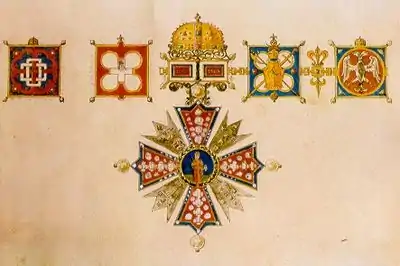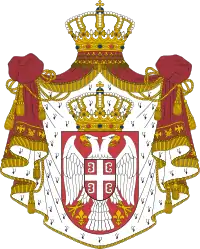Order of St. Prince Lazar
The Order of Saint Prince Lazar (Serbian: Орден Светог кнеза Лазара/Orden Svetog kneza Lazara) is a chivalric order created by King Alexander I of Serbia to commemorate the five hundredth anniversary of the Battle of Kosovo that took place on the 28 June 1389. It must not be confused with the Order of Saint Lazarus. The order is named after Prince Lazar who commanded the Serbian armies in the battle. The Order is worn only by the King of Serbia / King of Yugoslavia and by his Crown Prince (when of majority).
| Order of Saint Prince Lazar | |
|---|---|
 Grand Collar Set of the Order | |
| Awarded by Kingdom of Serbia / Kingdom of Yugoslavia | |
| Type | Dynastic Order |
| Established | 28 June 1889 |
| Royal house | Obrenović (until 1903) Karađorđević (from 1903) |
| Awarded for | Monarch and Heir apparent (only) |
| Sovereign | Crown Prince Alexander of Yugoslavia |
| Grades | Knight Grand Collar |
| Statistics | |
| Total inductees | 7 |
| Precedence | |
| Next (lower) | Royal Order of the Star of Karađorđe |
History
The order of Saint Prince Lazar was instituted by the Decision of the Parliament, signed by the King Aleksandar I, to commemorate the fifth centenary of the Battle of Kosovo (28 June 1389), that ended in the collapse of the medieval Serbian state. Saint Prince Lazar, of the Hrebeljanović family, commanded the Serbian armies that were defeated by the Ottoman Sultan Murat I. The Sultan was assassinated by Serbian knight Miloš Obilić, while captured the Serbian Prince was beheaded by the victorious Turks. The cult of the Saint Prince was very strong among Serbs, and the event was reckoned to be the paramount one in the entire history of Serbs. The commemoration of the 500th Anniversary took form of the Anointment of the King, and the Collar of Saint Prince Lazar ordered to be made by Nicolaus und Dunker of Hannau (Germany). The Order is worn only by the King of Serbia and by his Crown Prince (when of majority). Since inception, the Order has been worn only by the following:
Rewarding
The Collar of the Order was allowed to be worn only by the ruler of Serbia (later Yugoslavia) and the heir to the throne:
| Name | Date Awarded | Notes |
|---|---|---|
| King Alexander I of Serbia | 28 June 1889 | First holder of order after establishment |
| King Peter I of Serbia | 15 June 1903 | Second holder of order from rival dynasty |
| Crown Prince George of Serbia | 27 August 1905 | Abdicated 27 March 1909 |
| King Alexander I of Yugoslavia | 27 March 1909 | Took order after brother abdication |
| King Peter II of Yugoslavia | 28 March 1941 | Got order underage |
| Crown Prince Alexander of Yugoslavia | 17 July 1963 | In exile |
| Hereditary Prince Peter of Yugoslavia | 5 February 1998 | In exile |
 Aleksandar I Obrenovic, King of Serbia 1889–1903
Aleksandar I Obrenovic, King of Serbia 1889–1903 Peter I, King of Serbia and King of Serbs, Croats and Slovenes 1903–1921
Peter I, King of Serbia and King of Serbs, Croats and Slovenes 1903–1921 George, Crown Prince of Serbia 1903–1909
George, Crown Prince of Serbia 1903–1909 Alexander I, Crown Prince of Serbia 1909–1921, King of Serbs, Croats and Slovenes and King of Yugoslavia 1921–1934
Alexander I, Crown Prince of Serbia 1909–1921, King of Serbs, Croats and Slovenes and King of Yugoslavia 1921–1934
Peter II, King of Yugoslavia 1934–1945  Alexander, Crown Prince of Yugoslavia
Alexander, Crown Prince of Yugoslavia
1963 Peter, Hereditary Prince of Yugoslavia
Peter, Hereditary Prince of Yugoslavia
1998
Sign and a chain of the Order
Sign and a chain of the Order were made of gold and richly decorated with rubies, sapphires, emeralds, diamonds and pearls. Order for production was the German firm Nicolaus und Dunker. Sketches awards carried a professor of archeology Michael Valtrović.

The front side of the sign 
Revers
